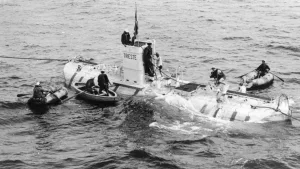Living Underwater
A major step forward in human underwater exploration was in the year 1960 with the maiden dive of the Trieste bathyscaphe, a submersible, to the Challenger Deep at a depth of almost 10,916 meters.

An ocean exploration company is currently investing around £ 100 m in a former deep diving site in U.K and repurposing it as a research facility to develop technology to allow people to live underwater aiming for a permanent human presence under oceans in the year 2027 . It will enable scientists to live underwater at depths of up to 200 m for up to 28 days at a stretch.

Discovering the Blue Planet
Scientists have explored only 3 % of the ocean . More is known about the solar system than about the oceans. There are better maps of Mars than of the ocean floor. The deepest part of the ocean , the Marianas trench , is enough to submerge Mount Everest .In the Marianas trench explorers have discovered presence of colonies of amphipods , transparent creatures resembling shrimps.
Darkness
Breathing underwater is possible and drowning is easily avoidable with the technology used by scuba divers and other rescue teams. However at a depth of 200 meters light does not penetrate and it is completely dark. At a depth of 400 m the temperature is as low as that of a refrigerator. The pressure of water is the killer .Death would be instantaneous but not in a pleasant or pretty way. Unassuming shrimps at the bottom of the sea withstand a pressure of 16,000 pounds per square inch (1125 kg per square centimeter) without a shell or any kind of protection. Such is the might of evolution and nature.
Titanic re visited
After the disastrous submersible touristic trip to the wreckage of the Titanic deep sea exploration has come into the limelight. So far 12 astronauts have spent a collective total of 300 hours on the lunar surface while only 3 people have spent around three hours exploring Challenger Deep, the deepest known point of Earth’s seabed, according to the Woods Hole Oceanographic Institute.
In a typical crewed submersible a two-man crew can sit in a sphere with 12.7 cm (5”) thick steel walls and film through a single plexiglass window with floodlights . Magnetic iron pellets are used as ballast to keep the submersible upright. To descend water is taken in the water ballast tanks which makes the submersible heavy to sink. To ascend some of the pellets and water is released from the water ballast tanks. Initially the Trieste had tanks filled with aviation fuel so the submersible could float up as fuel is lighter than water. Another advantage of using fuel was that instead of air it would not be compressed by the intense pressure of the water. Propellers push a submersible forward and a rudder steers the submersible. The ocean bed is not smooth but rugged .The Hadalpelagic is the deepest part of the ocean that includes the ocean trenches. It extends from 19,700 feet (6,000 meters) to the bottom of the Mariana Trench at 36,070 feet (10,994 meters). Not surprisingly plastic debris has been found at the Mariana Trench . It seems that prior to humans inhabiting the ocean floor plastic debris is preceding them.
Monopoly
No country has a monopoly over deep water exploration. All maritime countries are equally placed in the scientific perspective of deep sea exploration and mapping. Maldives has developed restaurants 16 feet below the sea with a 180 degree panoramic view. A Muslim maritime bloc could take the lead and initiate a scientific program through the platform of the Organisation of Islamic Conference (OIC) . Extensive funding is possible if the Gulf and Arab oil producing countries utilise a fraction of their hydrocarbon revenue streams towards under water mapping and exploration. The outcome would be beneficial in terms of a better understanding of ocean conservation, tidal movement, deep sea temperature variation, exploiting under sea marine and other resources in a sustainable manner, renewable energy prospects and preventing global warming.
Authored by Nadir Mumtaz
Credit /Source ;
https://www.bbc.com/news/uk-england-gloucestershire-66729172
https://www.scienceabc.com/nature/can-humans-live-underwater.html
https://letstalkscience.ca/educational-resources/backgrounders/human-exploration-deep-ocean
https://ocean.si.edu/ecosystems/deep-sea/deep-sea

Leave A Comment